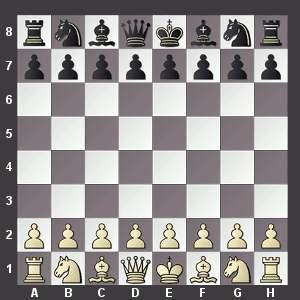Chess is a beautiful “Game”, it’s not easily mastered, even experienced players can still learn more, but you don’t have to be an expert to enjoy playing Chess.
Over the following weeks, we will guide beginners through the basics and more, hopefully you’ll discover the enjoyment that Chess can give you.
The following topics are what will be covered to help Juniors and beginners get started on this epic journey.
Board / Pieces setup

Note white square bottom right hand corner.
There are FOUR simple things that every chess player should try to achieve
1) Protect your King
Get your king to the corner of the board where he is usually safer. Don’t put off castling. You should usually castle as quickly as possible. Remember, it doesn’t matter how close you are to checkmating your opponent if your own king is checkmated first!
2) Don’t Give Pieces Away
Don’t carelessly lose your pieces! Each piece is valuable and you can’t win a game without pieces to checkmate. There is an easy system that most players use to keep track of the relative value of each chess piece.
How much are the chess pieces worth?
- A pawn is worth 1
- A knight is worth 3
- A bishop is worth 3
- A rook is worth 5
- A queen is worth 9
- The king is infinitely valuable
At the end of the game these points don’t mean anything – it is simply a system you can use to make decisions while playing, helping you know when to capture, exchange, or make other moves.
3) Control the Center of the Chessboard
You should try and control the center of the board with your pieces and pawns. If you control the center, you will have more room to move your pieces and will make it harder for your opponent to find good squares for his pieces.
4) Use All of your Chess Pieces
Your pieces don’t do any good when they are sitting back on the first row. Try and develop all of your pieces so that you have more to use when you attack the king. Using one or two pieces to attack will not work against any decent opponent.
Pins / Forks / Skewers / Discovered attacks
Forks: A fork is when a piece attacks more than one piece at a time, in a way that, whichever piece is moved or protected, the other will be able to be captured. Knights are usually the most dangerous.
Pins are when a piece cannot move without exposing another piece to capture.
Skewers are somewhat the opposite of pins, because here the more important piece is in the front and must move out of the way, exposing another piece behind it.
How to Draw a Chess Game
Occasionally chess games do not end with a winner, but with a draw. There are 5 reasons why a chess game may end in a draw:
- The position reaches a stalemate where it is one player’s turn to move, but his king is NOT in check and yet he does not have another legal move
- The players may simply agree to a draw and stop playing
- There are not enough pieces on the board to force a checkmate (example: a king and a bishop vs.a king)
- A player declares a draw if the same exact position is repeated three times (though not necessarily three times in a row)
- Fifty consecutive moves have been played where neither player has moved a pawn or captured a piece
Rules
Touch-move – If a player touches one of their own pieces they must move that piece as long as it is a legal move. If a player touches an opponent’s piece, they must capture that piece. A player who wishes to touch a piece only to adjust it on the board must first announce the intention, usually by saying “adjust”.
Notation
Recording moves in your game
Rows are lettered from A – H, Files or columns are numbered 1 – 8
It is important to learn this so that you can understand Algebraic Notation, check out the website below for further information.
www.blog.chesshouse.com/how-to-read-and-write-algebraic-chess-notation
Openings
Scholar’s Mate is the most common trap a beginner falls into, as White you may win a few games against beginners, but it’s not a good practice to get your queen out early.
The following game illustrates Scholar’s Mate. This is a checkmate whereby the Bishop and Queen attack the weak f7 pawn. This pawn is weak because, in the starting position, it is only protected by the King.
1.e4 e5 2.Bc4 Bc5 3.Qh5 Nf6 4.Qxf7#

This game can be played through in real time from GAMES in the menu bar.
To avoid Scholar’s mate Black should play 3………Qe7, then if 4Qxf7+? Qxf7 5. Bxf7+ Kxf7 leaving Black a Bishop for a Pawn ahead.
Middle Game Tactics / End Game Hints and Tips
These topics will be covered in more detail either at the Poole Chess Club or on Saturday mornings in Bournemouth Library.